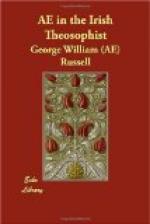I was awakened before dawn, those with whom I was to cross the desert were about to start and I could remain no longer. I wrote hurriedly to Asur a message full of warning and entreaty and set out on my return journey full of evil forebodings. Some months after I had again to visit the temple; it was evening when I arrived; after I had delivered the message with which I was charged, I asked for Asur. The priest to whom I spoke did not answer me. He led me in silence up to the terrace that overlooked the desolate eastern desert. The moon was looming white upon the verge, the world was trembling with heat, the winged bulls along the walls shone with a dull glow through the sultry air. The priest pointed to the far end of the terrace. A figure was seated looking out over the desert, his robes were motionless as if their wrinkles were carved of stone, his hands lay on his knees, I walked up to him; I called his name; he did not stir. I came nearer and put my face close to his, it was as white as the moon, his eyes only reflected the light. I turned away from him sick to the very heart.
—September 15, 1893
Jagrata, Svapna and Sushupti
While the philosophical concepts of ancient India, concerning religion and cosmogony, are to some extent familiar and appreciated in these countries, its psychology, intimately related with its religion and metaphysics, is comparatively unknown. In Europe the greatest intellects have been occupied by speculations upon the laws and aspects of physical nature, while the more spiritual Hindus were absorbed in investigations as to the nature of life itself; by continual aspiration, devotion, introspection and self-analysis, they had acquired vast knowledge of the states of consciousness possible for man to enter upon; they had laid bare the anatomy of the mind, and described the many states that lay between the normal waking condition of man, and the final state of spiritual freedom and unity with brahma, which it was the aim alike of religion and science to bring about. Most interesting among their ideas, was their analysis of the states of consciousness upon which we enter during sleep. Roughly speaking, they may be divided into two, which together with the waking state, make a trinity of states through which every person passes, whether he be aware of it or not. These states are known as:—–Jagrata, waking; Svapna, dreaming; and Sushupti, deep sleep. The English equivalents of these words give no idea of the states. Passing our of Jagrata, the Indians held that, beyond the chaotic borderland, we entered, in Svapna and Sushupti, upon real states of being. Sushupti, the highest, was accounted a spiritual state; here the soul touches vaster centres in the great life and has communion with celestial intelligences. The unification of these states into one is one of the results of Raj-Yoga; in this state the chela keeps memory of what occurred while his consciousness was in the planes of Svapna and Sushupti. Entrance upon these states should not I think be understood as meaning that the mind has deserted its fleshly tabernacle in search of such experience. Departure from the physical form is no more necessary for this than for clairvoyence, but a transfer of the consciousness in us from one plane to another is necessary.




